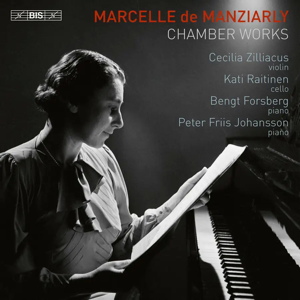
Marcelle de Manziarly (1899-1989)
Piano Trio (1921)
Nocturne for violin and piano (1977)
Dialogue for cello and piano (1970)
Violin Sonata (1918)
Trilogue for violin, cello and piano (1977)
Cecilia Zilliacus (violin), Kati Raitinen (cello), Bengt Forsberg (piano), Peter Friis Johansson (piano, Dialogue)
rec. 2022, Västerås Konserthus, Sweden
BIS BIS2689 SACD [69]
Marcelle de Manziarly, though born in Kharkiv, was a French composer, conductor, pianist and teacher, and an eminent student of Nadia Boulanger. She studied conducting with Weingartner and directed the first performance of her Piano Concerto with Alfredo Casella – no less – playing the piano. She spent the war years in America returning to France afterwards but thereafter moved back and forth between the two countries, teaching and composing.
One of her strengths was in the field of chamber music and that is what this SACD explores. The earliest works are the Violin Sonata and the Piano Trio and both are clearly reflective of the torrid influence of the First World War. The Piano Trio (1921) is programmed first and strikes a brusque tone, the piano frequently leading and setting the expressive agenda. Such lyricism as one finds is terse and provisional and if the scherzo offers a slight reprieve from the intensity we are plunged back in the succeeding slow movement, where dissonance is not slow to infiltrate the writing and the music gradually winds down, as if exhausted. It reawakens in the ostinato-obsessed finale though it ends decisively if not really in a spirit of uncomplicated closure. She was only 22 when she wrote this so it’s technically and geographically, as it were, an accomplished work but it’s wintry.
Her Violin Sonata of 1918 is more obviously cast in a French lineage, a kind of abstracted Fauréan idiom, but this time in three movements. The opening theme encodes a deliberate frailty that characterises the work but the sonata, a perceptive and advanced one for a woman of barely nineteen, is notable more for its clarity and directness. The slow movement reprises this spareness and its modality is notable too, as is a lyricism interrupted briefly by a moment of anguish. The finale’s tempestuous elements revisit the slow movement in effective contrast though this long movement ends the work on an apt note of sheer melancholy.
There is a great gap from these early works to her compositions from the 1970s. The Nocturne for violin and piano is atypically brief, wistful and uncomplicated but the earlier Dialogue for cello and piano (1970) is a sterner piece, elliptical and sparse. It’s too busy to be considered Webernian, perhaps, but its profile is decidedly and predominantly glowering. Trilogue is a piano trio written in 1977. At not quite ten minutes it offers a concise three-movement form – Prologue, Premonition and Epilogue – but in a terse, gaunt language that is only occasionally relived by brief lyricism that expands into nobility. There are a number of soliloquys for the three instruments and a kind of chiming resolution.
In these later works it’s not always easy to follow de Manziarly though that’s no fault of the performers. As so often Bengt Forsberg anchors things admirably, and violinist Cecila Zilliacus is both resilient and sensitive as is cellist Kati Raitinen whom Peter Friis Johansson accompanies in the Dialogue. The recording, to which I listened on my CD (not SACD) set-up, is excellent and serves de Manziarly well. I just wish I could respond to her music more wholeheartedly but that’s a personal failing.
Jonathan Woolf
Buying this recording via a link below generates revenue for MWI, which helps the site remain free.




















